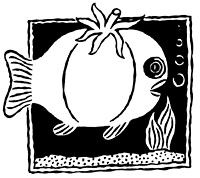It's Not Nice to Fool Mother Nature
Understanding the Science
By Virginia B. Wood, Fri., Aug. 6, 1999
For the spliced genes to work in the new species, they must be introduced with a promoter that the original species will recognize. In the interest of speed, most genetic engineering of plants is done with viral promoters because they integrate their genetic material into the host cell very quickly. The drawback with viral promoters is that once they're spliced into the host plant, they can't be controlled or switched off. This can result in unpredictable side effects or pleiotropic effects such as salmon genetically engineered with a growth hormone gene growing too big too fast and also turning green, or genes for the color red placed in petunias causing decreased fertility and altered growth of roots and leaves.
This simplified explanation of genetic engineering technology is based on information researched and written by Dr. Ricarda Steinbrecher for the Women's Environmental Trust (WEN), one of Britain's leading environmental charities. Dr. Steinbrecher contributed a chapter on the science of genetic engineering to Farmageddon: Food and the Culture of Biotechnology (New Society Publishers, $16.95 paper) by Canadian biotech expert Brewster Kneen.
Where Are the Regulations?
|
illustration by Lisa Kirpatrick |
In a weekly column called "Focus on the Corporation," Washington journalists Russell Mokhiber and Robert Weissman reported that some public interest groups have sued the FDA, alleging the agency "violated federal law by allowing biotech foods onto the market without first adequately testing the foods for safety" or labeling them with necessary consumer information. The federal Food, Drug & Cosmetic Act incorporates the precautionary principle that a new food additive is presumed unsafe until it is established to be safe through standard scientific procedures. However, the FDA ruled in 1992 that genetically engineered foods are not new food additives. According to documents obtained during the discovery process of the lawsuit, this ruling was made over the objections of some FDA scientists who "warned that foods produced through recombinant DNA technology entail different risks than do their conventionally produced counterparts." The giant biotechnology firms (Monsanto, DuPont, et al) responsible for these products operate on the premise that genetic engineering is no different from the time-honored conventional selection and breeding processes, and the FDA seems to accept that explanation over the objections of many of their own scientific experts.
The danger here appears to be that the FDA (not unlike some other federal agencies) has long since forsaken its regulatory imperative and traded it in for a promotional role in speeding new products developed by giant agribusiness concerns onto the market. The formerly stringent review process necessary for new products has been replaced by a more congenial approval process. And though they disregard suggestions from their own scientists, FDA representatives consistently repeat the mantra that all decisions are based on "sound science." The upshot of this attitude change is that government agencies designed to regulate business and protect the public interest seem much more invested in product promotion and protecting the corporate sector from the public.
International Battlegrounds
United States agriculture and trade officials have been butting heads over the issue of genetically engineered foods with members of the international community for several years now. One of the most popular new tools used by U.S. officials to promote GE foods is the assertion that they are absolutely necessary to feed booming Third World populations in the new millennium. However, this emotional blackmail technique seems to have backfired on the FDA and the biotech firms when representatives of 20 African states published a statement denying that gene technologies are the answer to hunger in their countries. On the contrary, they stated their belief that it would "destroy the diversity, the local knowledge and the sustainable agricultural systems ... and undermine our capacity to feed ourselves." After this statement became public knowledge, U.S. trade officials pressured European Union (EU) representatives to bring the African countries into the GE fold with no success.
The trade war erupting over the EU's 10-year ban on importing American beef that has been treated with growth hormones is another case in point. A majority of the beef cattle raised in the U.S. are treated with growth hormones, and Europe represents a large export market, so American officials appealed the ban to the World Trade Organization (WTO). The WTO has twice ruled the boycott to be illegal, but the EU refuses to lift the ban, citing the fear shared by many Europeans that there are possible links between growth hormones and cancer. Therefore, U.S. trade officials last week levied 100% tariffs on a large list of European gourmet items (See "Tariffs" sidebar) to penalize boycott supporters in France, Germany, Denmark, and Italy. English products escape the stiff tariffs because the English will import U.S. beef.
In response to the EU boycott of American hormone beef, U.S. Secretary of Agriculture Dan Glickman appeared on ABC's World News Tonight, minimizing the concerns of European consumers by saying that European producers "simply refuse to modernize and don't have a reliable system of food regulation in place. They just don't have the same sophisticated mechanism to scientifically examine their food products and determine their safety that we do." Most U.S. government and business officials who are quoted regarding the EU beef boycott describe Europeans in condescending terms, using words like "hysterical, unsophisticated, or ignorant."
A Reasonable Voice
|
illustration by Lisa Kirpatrick |
The article decries the release of so many GE crops onto the world market before they were subjected to adequate scientific testing to determine the long-term behavior of the plants. It also raises legitimate concerns about why rules for the approval of GE foods are so much less stringent than those for the approval of new medicines using the same genetic engineering technology. The Prince of Wales points out that most of the benefits of GE technology accrue to the corporations who invented it and large corporate farming operations and wonders how hundreds of thousands of acres of genetically modified corn could be grown in the U.S. before it was known that the corn pollen would be toxic to monarch butterflies. Was the potential destruction of monarchs deemed an acceptable risk by the manufacturer of Bt corn, and if so, how many more negative environmental surprises can we expect from these transgenic crops?
Regarding the new claims that GE crops are the only way to feed the Third World's burgeoning population, Prince Charles raises the issue of whether or not there is any serious research to substantiate that grandiose claim and cites the rejection of GE technology by the leaders of 20 African countries. He also poses a very worthwhile question, namely "how much more could be achieved if all the research funds currently devoted to fashionable GM techniques (billions per year) were applied to improving methods of agriculture which have stood the test of time?"
In the conclusion to his "thought piece," the prince encourages the public to consider just what kind of a world they want to inhabit and pass on to their children, one that allows "the industrialization of life itself, redesigning the natural world" for the sake of convenience and corporate profit, or a world that adopts a "more considered approach ... making better, more sustainable use of what we have, for the long-term benefit of mankind as a whole."
Such an enlightened and reasoned approach to this contentious issue is encouraging: A respected environmentalist with no profit motive makes a compelling argument against potential Frankenstein's monsters in our food supply, in contrast to corporate biotech profiteers promoting science and technology as mankind's only savior. Consumer concerns about tampering with the balance of nature are legitimate and should be voiced repeatedly until governments and the businesses they support begin to listen.










